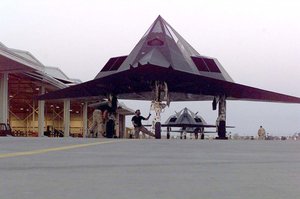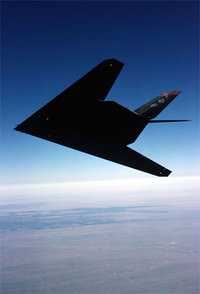F-117 Nighthawk
|
|
The United States Air Force's F-117A Nighthawk is the world's first operational aircraft designed to exploit low-observable stealth technology. It is a direct descendant of the Have Blue stealth prototype program.
| Contents |
Nicknames
Before it was given an official name, the engineers and test pilots referred to the ungainly aircraft, which went into hiding during daylight to avoid detection by Soviet satellites, as "Cockroaches", a name that is still sometimes used. A short lived hourglass on the bottom of one hinted at a nickname of "Black Widow", as in the black widow spider. Another sometimes used nickname is "Wobblin' Goblin," due to the aircraft's instability at low speeds, especially during in-flight refueling operations.
Mystery over designation
The Nighthawk is classified as a fighter (the "F-" designation), but it was designed primarily as a ground attack aircraft. A few websites claim that the F-117 can carry AIM-9 Sidewinder air-to-air missiles, but this seems contrary to the rest of the plane's design and reported missions. This is comparable to the earlier F-111, which, despite its F designation, was primarily a tactical bomber/interdictor.
The "F-" designation has never been officially explained. The USAF has always been proud of its fighters ("F-" aircraft) and at best ambivalent about the "mud mover" attack role. It may have been felt that an aircraft of radically new design would win support more easily if it was a new and different fighter rather than a bomber or attack aircraft.
The F-117 program was designed to employ the best fighter pilots, and the explanation given (on a recently televised documentary) by a senior member of the F-117 development team was that fighter pilots would be reluctant to fly a "B-" or even "A-" designated plane. There has been something of a class system separating fighter and bomber crews, particularly in the days of the Strategic Air Command (disbanded in 1991), and flying one type often limited a pilot's future prospects for flying the other.
One of the more common explanations for the "F-" designation of the Nighthawk was that it was for security reasons. The Nighthawk was secret until the late 1980s, and the fighter designation (as well as the continuation of the old numbering scheme that had ended with the F-111) may have been intended to help obfuscate the aircraft's true purpose. During development the term 'LT,' for Logistics Trainer, was often used.
Prior to the Air Force's confirmation about the design and designation, it had been postulated that the secret project was designated the F-19 and at least three model companies, Monogram, Revell and Testor's, produced "best guess" speculative kits, none of which actually resembles the real F-117.
The distinction between fighter and bomber may also have been decided by the F-117's range and payload, which make it a 'theater' (tactical) strike aircraft rather than a long-range strategic bomber. Indeed, the F-117 carries a smaller bombload than many USAF fighters, a consequence of the need to carry its weapons and fuel internally.
The USAF maintains that F-117 can carry every weapon in the inventory, including air-to-air missiles. That may be technically true, but the F-117 is neither designed nor suitable for air combat, lacking adequate maneuverability, speed, and sensors for that role. It could carry infrared missiles like the AIM-9 Sidewinder for self-defense, but since that would cut its offensive load in half, it's hardly practical. Since the F-117 lacks radar (and indeed, could not easily carry it without compromising its stealth capabilities), it cannot act as an interceptor in the beyond visual range role, where its low observability might be useful.
Some people speculate that the F-117 could be used to sneak up on AWACS or other large electronic warfare aircraft and shoot them down. This seems impractical since many aircraft within the 18 km engagement envelope of the AIM-9 missile could detect the F-117, especially an AWACS-type aircraft with its powerful, 360 degree sensing radar. An AWACS-type aircraft in a combat zone would usually have a fighter escort anyway. The F-117 would not be able to deal with fighters because it cannot turn at more than 5 g (49 m/s²) and is usually regulated to less than that. That, plus the lack of a cannon, would make the Nighthawk an easy target in a dogfight. The Nighthawk's black paint (which may be changed to a two-tone gray camouflage pattern in the future), easily reconizable shape, lack of supersonic speed, and lack of manuverability would make the aircraft a sitting duck for enemy fighters and surface defenses during the day. As a matter of necessity, all F-117 combat operations are performed at night.
The F-117's role is that of a strike aircraft used to attack a small number of high-priority targets. (It would potentially also be useful for reconnaissance missions, although there's little indication the USAF has pursued that role.) Its ideal designation might be the old British designation "TSR" (tactical strike/reconnaissance) used for the BAC TSR.2, although the USAF has no equivalent nomenclature.
Design and operation
The unique design of the single-seat F-117A provides exceptional combat capabilities. About the size of an F-15 Eagle, the twin-engine aircraft is powered by two non-afterburning General Electric F404 turbofan engines, and has quadruple redundant fly-by-wire flight controls. Air refuelable, it supports worldwide commitments and adds to the deterrent strength of the U.S. military forces. The avionics, fly-by-wire systems, and other aircraft parts are derived from two recent fighter aircraft, the F-16 Fighting Falcon and F/A-18 Hornet, in an attempt to lower costs. The F-117 was the first aircraft to be statically unstable in both pitch and yaw. This was done in order to improve manoeverability. The F-117 is said to have flying characteristics very similar to the F-16 although the performance was much lower.The penalty for stealth is mainly two-fold. First, the stealthy engine installation results in a power loss in the order of 30%, second, the high wing sweep angle which is needed to reflect incoming radar waves to the sides results in a very low aspect ratio of the wing.
The black colour of the fuselage has nothing to do with stealth. For minimum visibility at night, at the medium altitude where F-117 operates, a white bottom and a light gray top would be the best. The black color was chosen in order to make the aircraft look more intimidating.
The F-117A is equipped with sophisticated navigation and attack systems integrated into a digital avionics suite. In keeping with its stealth role, it does not carry radar (not only would radar emissions give away its location, the presence of a radar antenna would increase the aircraft's radar signature). Instead, it navigates primarily by GPS and high-accuracy inertial navigation (INS). Missions into highly defended target areas are coordinated by an automated mission planning system; indeed, all aspects of a strike mission, including weapons release, can be accomplished automatically. Target acquisition is accomplished by a thermal imaging infrared system, slaved to a laser that provides precise rangefinding and allows the F-117 to designate targets for laser-guided bombs.
The F-117A carries its weapons in a split internal bay capable of carrying up to 5,000 lb (2,300 kg) of ordnance. Typical weapons are a pair of GBU-10, GBU-12, or GBU-27 laser-guided bombs, two BLU-109 penetration bombs, two Wind-Corrected Munition Dispensers (WCMD), or two Joint Direct Attack Munitions (JDAMs), a GPS/INS-guided stand-off bomb. It can theoretically carry two examples of every weapon in the USAF inventory, including the B61 nuclear bomb.
History
The F-117A production decision was made in 1978 with a contract awarded to Lockheed Advanced Development Projects, the "Skunk Works," in Burbank, California. The first flight was in 1981, only 31 months after the full-scale development decision. The first F-117A was delivered in 1982, operational capability was achieved in October 1983, and the last delivery was in the summer of 1990. The Air Force denied the existence of the aircraft until 1988, then in April 1990 an example was put on public display at Nellis Air Force Base, Nevada, attracting tens of thousands of spectators.
During the program's early years, the F-117A fleet was based at Tonopah Test Range, Nevada from 1984 to mid-1992, where it served under the 4450th Tactical Group, absorbed by the 37th Tactical Fighter Wing in 1989. In 1992, the entire fleet was transferred to Holloman Air Force Base, New Mexico, where it was placed under the command of the 49th Fighter Wing.
Streamlined management by Aeronautical Systems Center, Wright-Patterson AFB, Ohio, combined breakthrough stealth technology with concurrent development and production to rapidly field the aircraft. The F-117A program has demonstrated that a stealth aircraft can be designed for reliability and maintainability. The aircraft maintenance statistics are comparable to other tactical fighters of similar complexity. Logistically supported by Sacramento Air Logistics Center, McClellan AFB, California, the F-117A is kept at the forefront of technology through a planned weapon system improvement program located at USAF Plant 42 at Palmdale, California.
Combat
The F-117 has been used several times in modern wars. Its first mission was during Operation Just Cause in Panama in 1989. During that invasion an F-117 dropped two bombs on Rio Hato airfield. Later, during the Gulf War, it performed well by dropping smart bombs on Iraqi military targets. It has since been used in the Kosovo War in 1999, Operation Enduring Freedom and Operation Iraqi Freedom.
Combat losses
One F-117 has been lost in combat, to Serbian/Yugoslav forces. On March 27, 1999, during the Kosovo War, the 3rd Battalion of the 250th Missile Brigade, equipped with the Isayev S-125 'Neva-M' (NATO designation SA-3 'Goa'), downed F-117A #82-806 with a liquid-fuelled Neva missile. According to Wesley Clark and other NATO generals, Yugoslav air defences tracked F-117s with old Russian radars operating on long wavelengths. This, combined with the loss of stealth when the jets got wet or opened their bomb bays, made them highly visible on radar screens. The pilot survived and was later rescued by NATO forces.
Specifications (F-117 Nighthawk)
General characteristics
- Crew: 1
- Length: 65 ft 11 in (20.08 m)
- Wingspan: 43 ft 4 in (13.20 m)
- Height: 12 ft 5 in (3.78 m)
- Wing area: 780 ft² (73 m²)
- Empty: 29,500 lb (13,380 kg)
- Loaded: 52,500 lb (23,814 kg)
- Maximum takeoff: lb ( kg)
- Powerplant: 2x General Electric F404-F1D2 turbofans, 10,600 lbf (48.0 kN) thrust each
Performance
- Maximum speed: km/h ( mph)
- Range: 800 nautical miles (1,500 km)
- Service ceiling: ft ( m)
- Rate of climb: ft/min ( m/min)
- Wing loading: lb/ft² ( kg/m²)
- Thrust/weight:
Armament
- 2x internal weapons bays with one hardpoint each (total of 2 weapons) including:
- Bombs: BLU-109 hardened penetrator, GBU-10 Paveway II laser-guided, GBU-27 laser-guided
- Missiles: AGM-65 Maverick air-to-surface, AGM-88 HARM air-to-surface
Related content
Related development: Have Blue - USS Sea Shadow
Comparable aircraft:
Designation series: XF-108 - F-110 - F-111 - F-117
See also:
- List of military aircraft of the United States
- List of current USAF aircraft
- List of fighter aircraft
|
Lists of Aircraft | Aircraft manufacturers | Aircraft engines | Aircraft engine manufacturers Airports | Airlines | Air forces | Aircraft weapons | Missiles | Timeline of aviation |
fr:Lockheed Martin F-117 Night Hawk he:F-117 nl:F-117 Nighthawk pl:F-117 Nighthawk pt:F-117 Nighthawk ja:F-117 (攻撃機)



